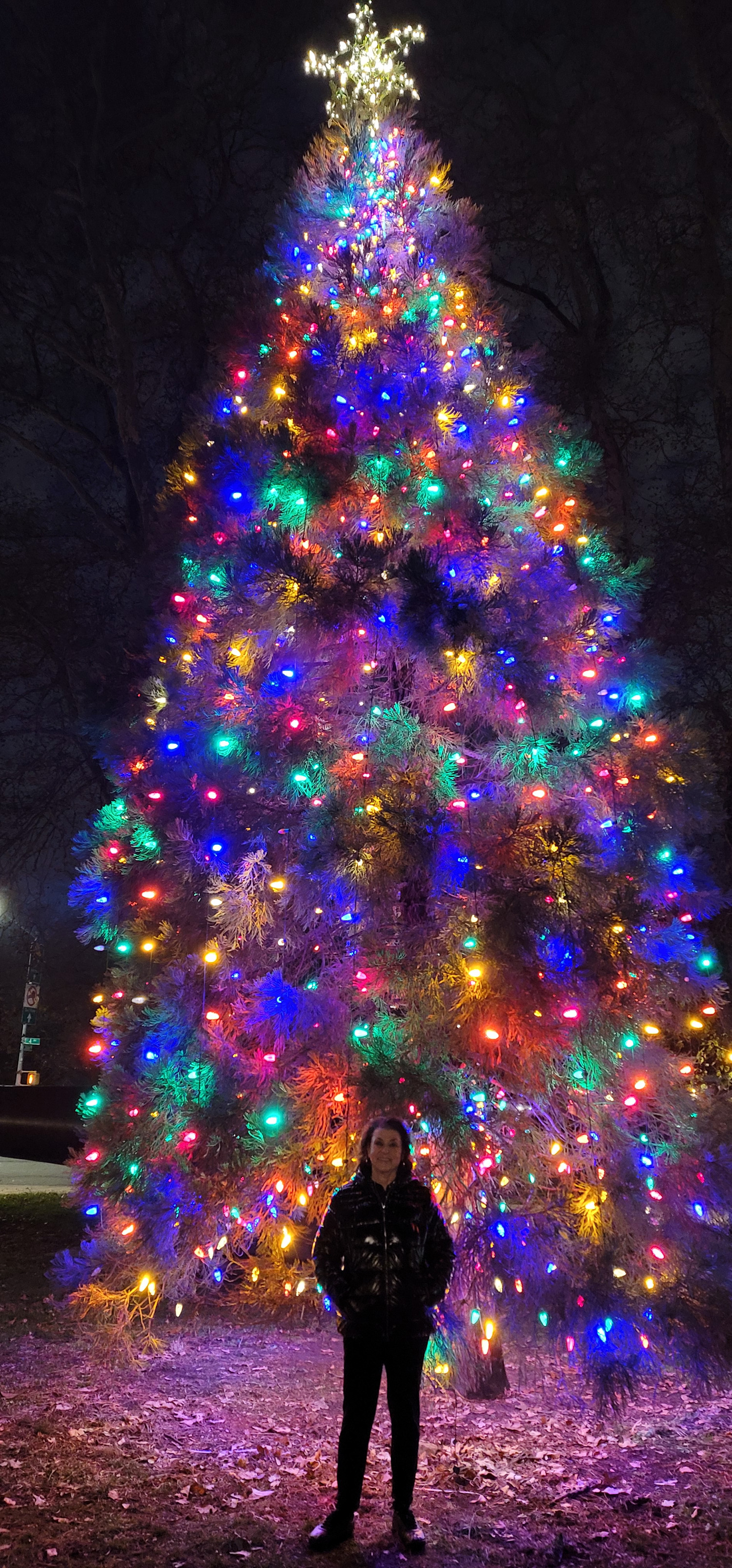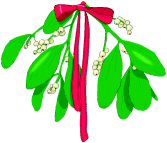

A Christmas tree is a decorated tree, usually an evergreen conifer such as spruce, pine, or fir or an artificial tree of similar appearance, associated with the celebration of Christmas. The modern Christmas tree was developed in early modern Germany (where it is today called Weihnachtsbaum or Christbaum), in which devout Christians brought decorated trees into their homes. It acquired popularity beyond the Lutheran areas of Germany, during the second half of the 19th century, at first among the upper classes.
The tree was traditionally decorated with "roses made of colored paper, apples, wafers, tinsel, and sweetmeats". In the 18th century, it began to be illuminated by candles, which were ultimately replaced by Christmas lights after the advent of electrification. Today, there is a wide variety of traditional ornaments, such as garlands, baubles, tinsel, and candy canes. An angel or star might be placed at the top of the tree to represent the Angel Gabriel or the Star of Bethlehem from the Nativity. Edible items such as gingerbread, chocolate and other sweets are also popular and are tied to or hung from the tree's branches with ribbons.
In the Western Christian tradition, Christmas trees are variously erected on days such as the first day of Advent or even as late as Christmas Eve depending on the country; customs of the same faith hold that the two traditional days when Christmas decorations, such as the Christmas tree, are removed are Twelfth Night and, if they are not taken down on that day, Candlemas, the latter of which ends the Christmas-Epiphany season in some denominations. The Christmas tree is sometimes compared with the "Yule-tree", especially in discussions of its folkloric origins
Long before there was a Christmas, Egyptians brought green palm branches into their homes on the shortest day of the year in December as a symbol of life's triumph over death.
Romans adorned their homes with evergreens during Saturnalia, a winter festival in honor of Saturnus, their god of agriculture.
Druid priests decorated oak trees with golden apples for their winter solstice festivities. In the middle ages, the Paradise tree, an evergreen hung with red apples, was the symbol of the feast of Adam and Eve held on December 24th.
The first recorded reference to the Christmas tree dates back to the 16th century. In Strasbourg, Germany (now part of France), families both rich and poor decorated fir trees with colored paper, fruits, and sweets.
The retail Christmas tree lot also dates back that far - in those times, older women would sell trees harvested from nearby forests.
The tradition spread through Europe and was brought to the United States by German settlers and by Hessian mercenaries paid to fight in the Revolutionary War.
In 1804 U.S. soldiers stationed at Fort Dearborn (now Chicago) hauled trees from surrounding woods to their barracks at Christmas.
The popularity of the Christmas tree then proliferated. Charles Minnegrode introduced the custom of decorating trees in Williamsburg, Virginia in 1842.
In 1851, Mark Carr hauled two ox sleds loaded with trees from the Catskills to the streets of New York and opened the first retail lot in the United States.
Scattered records from family diaries, journals, and letters indicate that early-day decorations included homemade cookies and "sugars", corn husk dolls, and various food ornaments such as pomander balls (apples or oranges studded with whole cloves and dusted with cinnamon).
Franklin Pierce, our 14th President, brought the Christmas tree tradition to the White House. In 1923, President Calvin Coolidge started the National Christmas Tree Lighting Ceremony now held every year on the White House lawn.
Since 1966, members of the National Christmas Tree Association have presented a beautiful, fresh Christmas tree to the President and first family. This tree is displayed each year in the Blue Room of the White House. Read more

The addition of tinsel as decoration comes from a legend about a poor old woman who was unable to provide decorations for her children's Christmas tree. During the night, spiders lodged in the tree and covered it with their webs. The Christ Child, seeing this, realized that the woman would be sad to see her surprise spoiled. He turned the spider webs into silver, and the next morning the poor family was dazzled by the brilliant "tinsel" that shone on the tree.
Tinsel was invented in Germany around 1610. At that time real silver was used, and machines were invented which pulled the silver out into the wafer thin strips. Though it was durable, it tarnished easily, so some attempt was made to make tinsel with lead and tin. This proved too heavy and breakable, so silver was actually used until the mid 20th century. Today, the tinsel we use is made generally of plastic.

Christmas decorations are said to be derived from a custom observed by the Romans of sending boughs, accompanied by other gifts, to their friends during the festival of the Saturnalia, a custom the early Christians adopted. In confirmation of this opinion, a subsequent edict of the Church of Bracara has been quoted, forbidding Christians to decorate their houses at Christmas with green boughs at the same time as the pagans, the Saturnalia commencing about a week before Christmas. The origin has also been traced to the Druids, who decorated their huts with evergreens during winter as an abode for the sylvan spirits. In old church calendars we find Christmas Eve marked templa exornantur (churches are decked), and the custom is as deeply rooted in modern times as in either pagan or early Christian days.
An old legend declares that the Holly first sprang up under the footsteps of Christ, when He trod the earth, and its thorny leaves and scarlet berries, like drops of blood, have been thought symbolical of the Saviour's sufferings, for which reason the tree is called 'Christ's Thorn' in the languages of the northern countries of Europe. It is, perhaps, in connexion with these legends that the tree was called the Holy Tree, as it is generally named by our older writers. Turner, for instance, refers to it by this name in his Herbal published in 1568. Other popular names for it are Hulver and Holme, and it is still called Hulver in Norfolk, and Holme in Devon, and Holme Chase in one part of Dartmoor.
Pliny describes the Holly under the name of Aquifolius, needle leaf, and adds that it was the same tree called by Theophrastus Crataegus, but later commentators deny this. Pliny tells us that Holly if planted near a house or farm, repelled poison, and defended it from lightning and witchcraft, that the flowers cause water to freeze, and that the wood, if thrown at any animal, even without touching it, had the property of compelling the animal to return and lie down by it.
Druids believed the holly or ilex was sacred. They thought this plant stayed green year round because it was especially favored by the sun. Christian legend says one winter night, the holly miraculously grew leaves out of season in order to hide the Holy Family from Herod's soldiers. Since then, it has been an evergreen as a token of Christ's gratitude.
Holly is one of the trees said to be the tree of Christ's cross. Legend tells us that the trees of the forests refused the defilement of the cross, splintering into tiny fragments at the touch of the ax. Only the holly behaved like an ordinary tree, allowing itself to be cut and formed into a cross. It is as a Passion symbol that holly is found in pictures of various saints. It's presence indicates that the saint is either reflecting upon Christ's Passion or foretelling it.
In Germany, holly is called Christdorn in memory of Christ's crown of thorns. According to legend, the holly's branches were woven into a painful crown and placed on Christ's head while the soldiers mocked him saying, "Hail, King of the Jews." The holly's berries used to be white but Christ's blood left them with a permanent crimson stain.
Another legend about this Christmas plant says that a little orphan boy was living with the shepherds when the angels came to announce the birth of the newborn king. Having no gift for the baby, the child wove a crown of holly branches for its head. But when he lay it before Christ, he became ashamed of it's poverty and began to cry. Miraculously, Jesus touched the crown and it began to sparkle while the orphan's tears turned into beautiful scarlet berries.
Many superstitions surround the holly. It is a man's plant and is believed to bring good luck and protection to men while ivy brings the same to women. It is thought that whoever brings the first sprig of Christmas holly into the home will wear the pants that year. It was hung about the doors and windows to keep away witches, spells, evil spirits, goblins, and lightning. On Christmas eve, English virgins hung holly on their beds to protect their virtue from Christmas goblins. However, elves and fairies were welcome in British households, and sprigs of holly were hung as hiding places for them. Romans gave gifts of holly to their friends during Saturnalia as good luck charms and protection against evil. Because of all these superstitions, early Christians were forbidden to decorate with this plant, especially during Saturnalia.

While many Christmas traditions have pagan origins, this secular little Christmas goody is steeped in Christian symbolism. According to legend, a candymaker wanted to make a confection to honor Christ's birth. It had to be hard candy to represent the church being built on solid rock. Because Jesus is known as the 'Good Shepherd', it was formed in the shape of a shepherd's staff (and turning it upside down, it was a "J" for Jesus). The three small red stripes represented the scourging Jesus suffered on his way to the cross. The one large red stripe represented the blood Jesus shed as payment for our sins. The white stripes represented the virgin birth and the sinless nature of Christ.

Also known as the golden bough, mistletoe was held sacred by both the Celtic Druids and the Norseman. Celts believed this parasitic plant held the soul of the host tree, the holy oak. In a special ceremony, the Druid priests would harvest it with a golden sickle making sure it never touched the ground where it's magical powers would be absorbed back into the earth. The branches were then divided and distributed to the people who used it as a protection from all sorts of evils. Once called 'Allheal', it has been used as a folk medicine to heal toothache, measles, and many other ills.
The practice of 'kissing under the mistletoe' has many legends associated with it. Some say the Druids dedicated the plant to the Goddess of Love, and this is where the custom comes from. Others claim it came from England, where mistletoe was hung in doorways for good luck. Since only happiness could pass beneath it, enemies would embrace and seal their peace with a kiss of friendship. Scandinavians also considered it the plant of peace, and if enemies met by chance beneath it in the forest, they laid down their arms and maintained a truce until the next day. Even now, if there is armed conflict anywhere in the world, there is usually a cease-fire on Christmas Day, which is probably a custom that has come down from these practices in antiquity.
Norse Legend ... Frigga, wife of the god Odin, dearly loved her son Balder and took steps to make sure no harm would come to him by earth, fire, water or air. Since mistletoe did not fit into any of these realms, an evil spirit names Loki fashioned an arrow of it and gave it to Balder's blind brother, Holder. Guided by Loki's (Trickster) hand, Holder unknowingly shot his brother in the heart, killing him. The legend has several outcomes. In one, Balder is brought back to life. In another, He was sent to the Otherworld with a Viking's funeral, on a burning ship, to await the day when He returns to Earth to usher in a new era. In both cases, Frigga swore that mistletoe would never again cause harm; making it a symbol of love and promising to bestow a kiss upon anyone who passed under it.